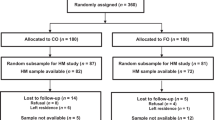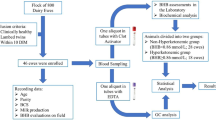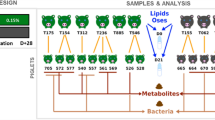Abstract
Objective: To determine the lipid components of colostrum and the fatty-acid (FA) composition of the colostrum and serum of Iraqi mothers, whether their delivery be fullterm (FT) or preterm (PT).
Design: A collection of colostrum and serum samples of FT and PT delivering Iraqi mothers.
Setting: Mosul province (in the north of Iraq).
Subjects: Colostrum and blood samples were obtained from FT and PT delivering mothers; their gestation periods were 39.2 and 32.7 weeks, respectively (age 20–40 y).
Procedures: Colostrum and serum samples were collected from each lactating mother. The nursing period was 3–5 days. The lipid components of colostrum, namely triglycerides (TGs) and cholesterol (C), were determined enzymatically and the phospholipids (PLs) were determined by using a colorimetric method based on the formation of a phosphomolybdate complex. The FA composition of colostrum and serum was determined by capillary gas chromatography.
Results: Compared to PT colostrum, FT colostrum exhibited a significant increase in lipid content, viz. TGs (P=0.022); a significant decrease in medium chain fatty acids (MCFAs), viz. C12 and C14 (P=0.03 and 0.005, respectively); no significant differences in monounsaturated fatty acids and a significant increase in C20:5 n3 and C22:6 n3 (P=0.001 and 0.05, respectively) and a slight increase in the level of n3/n6. The FA composition of the mother serum was found to mimic that of their colostrum, except for the level of MCFAs which was higher in the colostrum.
Conclusion: The lipid content, the percentage of C22:6 n3 (the most important FA) and the level of n3/n6 in PT colostrum were lower than those in FT colostrum. They may be affected by serum lipid and immaturity of the mammary gland. Generally, the level of n3/n6 for both groups (0.09 and 0.08) is lower than that recommended by WHO (0.1) for infants’ optimum nutrition. The difference in the level of MCFAs between the mother serum and colostrum reflects their de novo synthesis in the mammary gland.
Sponsorship: Supported by Grants from Department of Chemistry, College of Education, University of Mosul. The analysis of fatty acid-methyl ester samples was performed at the National Centre for Scientific Research (CNRS), France.
This is a preview of subscription content, access via your institution
Access options
Subscribe to this journal
Receive 12 print issues and online access
$259.00 per year
only $21.58 per issue
Buy this article
- Purchase on Springer Link
- Instant access to full article PDF
Prices may be subject to local taxes which are calculated during checkout

Similar content being viewed by others
References
Agostoni C, Maragoni F, Bernardo L, Lammardo AM, Gali C & Riva E (1999): Long-chain polyunsaturated fatty acids in human milk. Acta Paediatr. Suppl. 88, 68–71.
Ali AM, Al-Shebibi M, Al- Umar ME & Toma SJ (1984): Dairy Chemistry. Mosul: Iraq, Mosul University Press. pp. 31–57.
Al-Tamer YYH (1974): Analysis of lipoprotein fractions separated by density gradient ultracentrifugation. MSc Thesis, University of Surrey: UK.
Ambartsumyan G (1998): Maternal milk more essential than we think. Noteworthy Nutr. Paper 1, 1–4.
Beijers RJ & Schaafsma A (1996): Long-chain polyunsaturated acids content in Dutch preterm breast milk; differences in the concentrations of docosahexaenoic acid and arachidonic acid due to length of gestation. Early Hum. Dev. 44, 215–223.
Bitman J, Wood DL, Hamosh M, Hamosh P & Mehta NR (1983): Comparison of the lipid composition of breast milk from mothers of term and preterm infants. Am. J. Clin. Nutr. 38, 300–312.
Bunker CH, Ukoll FA, Okoro FI, Olomu AB, Kriska AM, Huston SL, Markovic N & Kuller LH (1996): Correlates of serum lipids in a lean black population. Atherosclerosis 123, 215–225.
de-Jong C & Bading HT (1992): Determination of free fatty acids in milk and cheese. Procedures of extraction, clean up and capillary gas chromatographic analysis. J. High Resol. Chromatogr. 13, 94–98.
Ehrenkranz RA, Ackerman BA & Nelli CM (1984): Total lipid content and fatty acid composition of preterm human milk. J. Pediatr. Gastroenterol. Nutr. 3, 755–758.
FAO/WHO (1994): Fats and Oils in Human Nutrition, Report of Joint Expert Consultation. FAO, Rome, FAO Food and Nutrition 57, pp 1, 3, 4, 10 and 9.
Folch J, Lees M & Sloane-Stanely GH (1957): A simple method for the isolation and purification of total lipids from animal tissues. J. Biol. Chem. 226, 497–509.
Genzel-Boroviczeny O, Wabel J & Koltezko B (1997): Fatty acid composition of human milk during the first month after term and preterm delivery. Eur. J. Pediatr. 156, 142–147.
Gerster H (1998): Can adults adequately convert alpha-linolenic acid to eicosapentaenoic acid and docosahexaenoic acid. Int. J. Vitam. Nutr. Res. 68, 159–173.
Gibson RA & Makrides M (1998): The role of LCPUFAs in neonatal nutrition. Acta Paediatr. 87, 1017–1022.
Giovannini M, Agostoni C & Salari PC (1991): The role of lipids in nutrition during the first months of life. J. Int. Med. Res. 19, 351–362.
Gunstone FD, Harwood JL. & Padely FB (1994) 2nd Edition The Lipid Hand Book. London, UK, Champan & Hall. pp. 195, 243–244.
Harzer G, Dieterich I & Haug M (1984): Effects of the diet on the composition of human milk. Ann. Nutr. Metab. 28, 231–239.
Hurely WL. : Department of Animal Science. Milk fat synthesis. University of Illinois: Urbana-Champaign. (Internet).
Jensen RG (1999): Lipids in human milk. Lipids 34, 1243–1271.
Jensen RG, Lammi-Keefe CJ, Hill DW, Kind AJ & Henderson R (1998): The anticarcinogenic conjugated fatty acid, 9c, 11t-18:2 in human milk: conformation of its presence. J. Hum. Lact. 14, 23–27.
Minihane AM, Leigh-Firbank EC, Leak DS, Wright JW, Murphy MC & Griffin BA (2002): Eicosapentaenoic acid and docosa-hexaenoic acid from fish oils: differential associations with lipid responses. Br. J. Nutr. 87, 435–445.
Morgan C, Stammers J, Colley J, Spencer SA & Hull D (1998): Fatty acid balance studies in preterm infants fed formula milk containing long chain polyunsaturated fatty acids (LCP). Acta Paediatr. 87, 318–324.
Nordiy A, Marchiolo R, Arnesen H & Videback J (2001): n-3 polyunsaturated acids and cardiovascular diseases. Lipids 36, S127–S129.
Ogunleyne A, Fakoya AT, Miizeki S & Tojo H. (1991): Fatty acid composition of breast milk from Nigerian and Japanese women. J. Nutr. Sci. Vitaminol. 37, 435–442.
Rocquelin G, Tapsoba S, Dop MC, Mbemba F, Traissac P & Martinprevel Y (1998): Lipid content and essential fatty acid (EFA) composition of mature congolese breast milk are influenced by mother's nutritional status. Eur. J. Clin. Nutr. 52, 164–171.
Rueda R, Ramirez M, Garcia-Salmeron JL, Maldonado J & Gil A (1998): Gestational age and origin of human milk influence total lipid and fatty acid contents. Ann. Nutr. Metab. 42, 12–22.
Spear ML, Homosh M, Bitman J & Wood DL (1992): Milk and blood fatty acid composition during two lactations in the same woman. Am. J. Clin. Nutr. 56, 65–70.
Suh M, Wierzbicki AA & Clandinin MT (1994): Dietary fat alter membrane component in rod outer segments in normal and diabetic rats; Impact on content of very long chain (C⩾24) polyenoic acids. Int. J. Biochem. and Biophys. 1214, 54–62.
Tietz NW (1986): Textbook of Clinical Biochemistry, pp. 135. Philadelphia, PA USA: WB Saunders Co.
Wilson TA, Nicolosi RT, Chrysam M & Kritchevsky D (2000): Conj. Linoleic acid reduces early aortic atherosclerosis greater than linoleic acid in hypercholesterolemic hamesters. Nutr. Res. 20, 1795–1805.
Woltil HA, Van-Beusekom CM, Schaafsma A, Muskiet FAJ & Okken A. (1998): Long chain polyunsaturated fatty acids status and early growth of low weight infants. Eurp. J. Pediatrics 157, 146–152, (abstract).
Wu FC, Ting YY & Chen HY (2002): Docosahexaenoic acid is superior to eicosapentaenoic acid as the essential fatty acid for grwoth of grouper, epinephelus malabaricus. Am. Soci. Nutr. Sci. 132, 72–79.
Yeh LL, Kuller LH, Bunker CH, Ukoli FA, Huston SI & Terrell DF (1996): The role of socioeconomic status and serum fatty acids in the relationship between intake of animal foods and CVD risk factors. Ann. Epidemiol. 6, 290–298.
Acknowledgements
We thank the French Embassy for granting a 2-month research fellowship without which the analysis of samples by capillary gas chromatography would never have been carried out, since this technique is still not available in Iraq. Also, we express our gratitude to Dr Christian Marazano, Dr Stephane Mons, Dr Alice Olsker and Wafaa’ Al-Sheikh, the staff of the laboratory of CNRS, France, who provided the facilities for the analysis performed. The cooperation of a large number of volunteers and the nursing staff of Al-Khansaa’ Maternity Hospital is sincerely acknowledged.
Author information
Authors and Affiliations
Corresponding author
Rights and permissions
About this article
Cite this article
Al-Tamer, Y., Mahmood, A. Fatty-acid composition of the colostrum and serum of fullterm and preterm delivering Iraqi mothers. Eur J Clin Nutr 58, 1119–1124 (2004). https://doi.org/10.1038/sj.ejcn.1601939
Received:
Revised:
Accepted:
Published:
Issue Date:
DOI: https://doi.org/10.1038/sj.ejcn.1601939
Keywords
This article is cited by
-
The influence of Iraqi mothers' socioeconomic status on their milk-lipid content
European Journal of Clinical Nutrition (2006)



